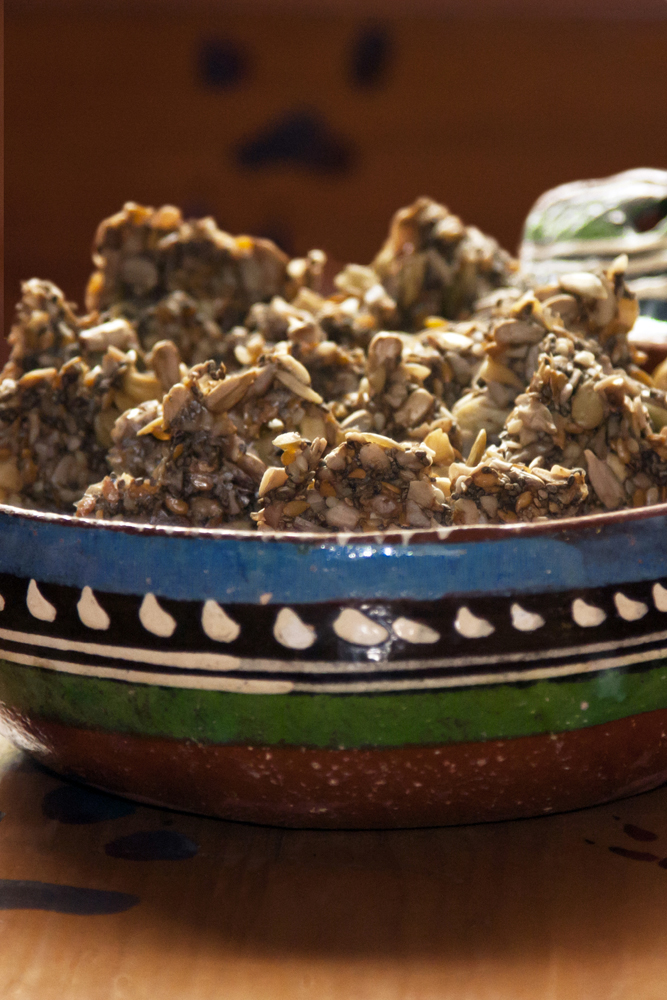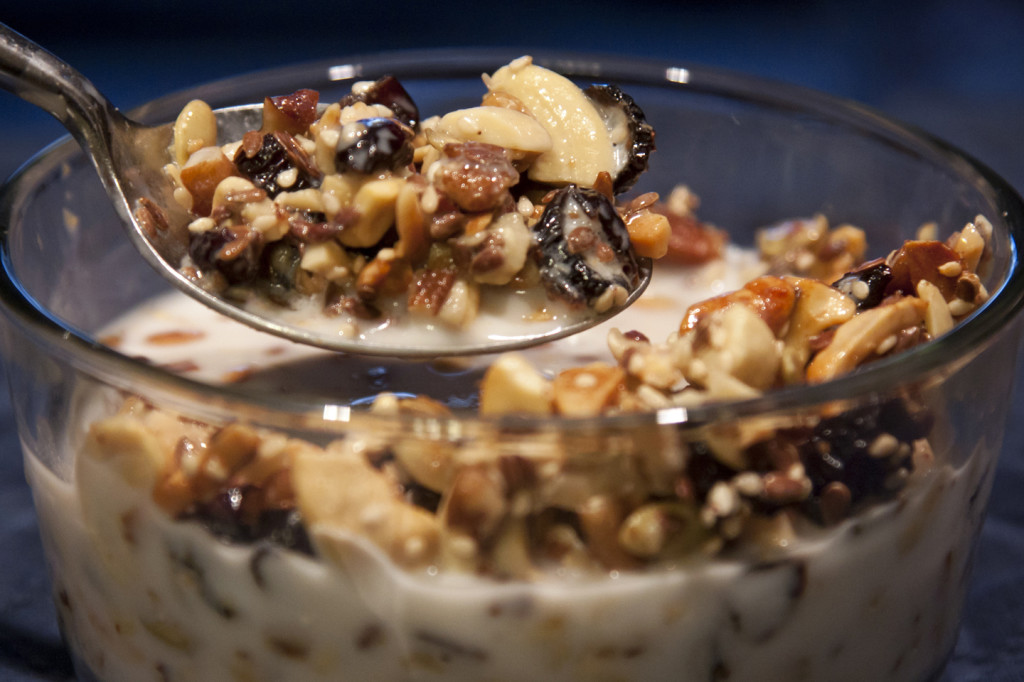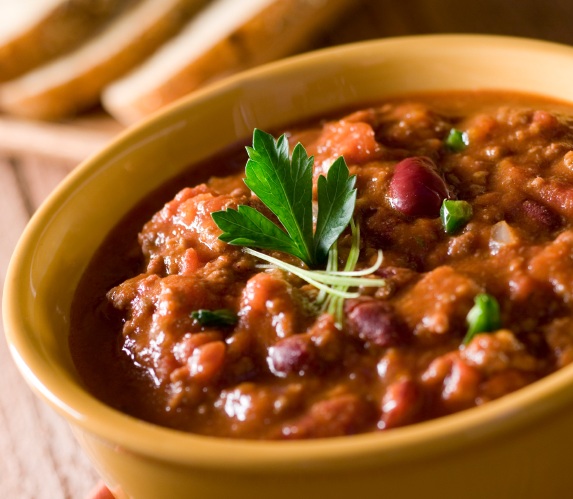In more than a few recipes I talk about soaking or sprouting seeds and beans.
In my Eating to Restore Balance class, I mention soaking seeds, beans, and nuts
Why?
A long list of health benefits you soak your grains, beans, nuts and seeds:
- Break down phytic acid
- Neutralize enzyme inhibitors
- Eliminate or reduce lectins, gluten, tannins, goitrogens, and other anti-nutrients that contribute to unwanted problems
- Activate enzymes that help digest food and released nutrients
- Increase nutrient content, especially vitamin B and anti-oxidants
- Break down hard-to-digest proteins in cereal grains—if you must have cereal grains
- Increase your digestive tract’s ability to digest proteins
- Prevent mineral deficiencies and bone loss
- Reduce hypersecretion of pancreatic enzymes
- Maximize other digestive processes, taking the burden off your organs while releasing maximal nutrients
Pesky phytic acid and other anti-nutrients solved by soaking
Grains, beans, nuts and seeds are promoted as the nutritional staple of vegetarians, vegans, sometimes plant-based diets, and many world cultures. But Mother Nature equipped these foods with an arsenal of weapons known as anti-nutrients. These toxic anti-nutrients protect seeds from insects and predators, from invasion by bacteria, viruses or fungi, from digestion in the gut so they are safely eliminated with the rest of the “waste” and deposited where they may produce a new plant.
Phytic Acid and Mineral Deficiencies
Phytic acid is the major storage form of phosphorous in cereals, legumes, oil seeds and nuts (this is good, right? We need phosphorous for bones? Read on).
Known as a food inhibitor, phytic acid chelates (literally means “having pincer-like claws” from Greek khele “claw”) or binds certain nutrients, especially trace minerals and including phosphorous, preventing them from being released during our digestive process because we lack the necessary enzymes in our digestive tract.
By the way, those grain-based dog and cat foods? Your pets don’t make that enzyme either.
Phytic acid (or phytate) protects the plant seed from premature germination. When you eat foods with these phytic acids still intact, they bind with important minerals such as calcium, zinc, magnesium, iron and copper and prevent absorption. Phytic acid also has the potential to block protein absorption.
Over time, regularly consuming foods (processed or whole) that contain phytic acid can lead to serious mineral deficiencies. Being mineral deficient causes a variety of health problems, especially thyroid and adrenal gland imbalances as these glands need minerals to function. Beyond decaying teeth, bone loss, anemia and hormone disruption, being mineral deficient can cause digestive irritability, impaired immune function, allergies, skin irritations and overall poor growth and development in infants and children.
Please think about this as you select high phytate baby foods like cereal, crackers, bread, nut butters and especially soy formula. And please continue to think about this if your child grows up on PB&J’s, cereal, and seed-based snacks.
Enzyme Inhibitors
Plant seeds, especially nuts and seeds, also contain enzyme inhibitors—potentially to ensure dormancy until conditions are right for germination, but possibly also to avoid being digested—many of these inhibitors block enzyme function, most notably the uptake of trypsin, an enzyme responsible for digesting protein.
In animal research (about that pet food…) consuming large amounts of foods containing trypsin inhibitors means the pancreas has to hyper-secrete enzymes. In animals, this lead to enlarged pancreas and benign tumors.
This is especially concerning for vegans and vegetarians who attempt to use seeds (beans and nuts are seeds) as their primary protein source and may explain some of the muscle wasting and inflammation seen on these diets.
Lectins
A family of proteins that readily bind to sugars and starches, lectins are found in many food types but are most highly concentrated in legumes and cereal grains—especially the bran of cereal grains.
In fact, different blood types are determined by whether or not red blood cells clump (or “agglutinate” in the presence of specific lectins—a form of individuality that may underlie blood type diet theories.
Eating foods with high lectin activity (termed “hemagglutinating” activity), especially soy beans and wheat, may lead to diarrhea, nausea, bloating, and vomiting. Research has shown that eating improperly prepared soybeans can disrupt small intestine metabolism and damage small intestinal villi because these carb-binding lectins bind with the sensitive villi in the lower part of small intestine. This prevents them from properly transporting nutrients into your bloodstream.
This also partially explains the way wheat, high in lectins and also high in gluten—both damaging to your intestine—can cause damage to your intestinal tract. Lectins are highest in the bran coating which is why lectins are higher in wheat-based meusli, granola and whole grain products than their processed counterparts. Not that you should eat the processed version with its blood sugar spiking and other problems.
“Leaky gut” means that the very delicate lining of the small intestine is so damaged that particles of undigested food, proteins, toxins and other pathogens are able “leak” through the digestive barrier and into the bloodstream. Your body dutifully mounts an immune response (increased inflammation), often produces antibodies to these foreign particles that leaked through the gut barrier before fully processed (food allergies).
Most autoimmune diseases occur because there are similarities between the foods we eat and the construction of our bodies. In other words, your body has made an antibody to something it found leaking through your gut barrier (foreign invader) but it “looks” enough like the make-up of your organs that your body attacks those as well. This is why lectins (as well as the cereal grain gluten and gliadins) are linked with autoimmune disorders like IBS, Chron’s, colitis, thyroiditis, fibromyalgia, and arthritis.
Sadly, soaking, fermenting, and even cooking does not remove or inactivate lectins.
Beans… So Hard to Digest
Beans are a beloved staple for many vegans and vegetarians for their frugality and protein content. They are delicious and filling, but they also cause undesirable digestive issues. The obvious of these is gas, bloating, cramping and indigestion.
Besides the lectins and phytic acid contained in most legumes, the harder beans such as kidney beans, navy beans and black beans contain oligosaccharides—a form of complex starch/sugar that we cannot digest. When these oligosaccharides reach your large intestine, they are fermented producing carbon dioxide and methane gases.
Although soaking doesn’t change these fermentable starches, they leach from the beans into the soaking water. Toss the water, and you’ve tossed much of the problem.
So, does everyone need to soak their nuts and seeds? All the time?
The point of soaking is to break down anti-nutrients and release nutrients.
So as much as I would like to answer “yes, of course!”, it’s not that simple. Soaking can be time consuming, and it is important to know that the process is worth investing in.
Generally, a robust and healthy digestive system can tolerate a certain amount of these anti-nutrients. When beans and seeds are only eaten occasionally, and especially if eaten with living greens and veggies providing additional enzymes that compensate for the actions of enzyme inhibitors, then it might be fine not to worry about soaking or sprouting.
But most of our digestive tracts are not healthy. And most of the meals we’ve eaten for years were high-phytate and anti-nutrient foods. Switching now to nut flours in pancakes or buckwheat cereal or legumes in soups/chili, while a great choice, if you want to heal you’ll have to be more conscious about preparing these seeds properly.
An unhealthy digestive tract really cannot handle much of this.
We’re all different; most definitely soak your seeds if you:
- experience low belly pain after eating nuts, seeds or foods that contain them?
- notice pieces of seeds/nuts in their stool the day after eating them?
- eat a significant amount of phytate containing foods- such as grains, beans, nuts and seeds?
- struggle to consume enough minerals and B-vitamins in your diet?
Soaking can make a big difference, can even make that food work for the person where before it created indigestion. But if not any of these situations, they can soak them only when a main component of their meal and don’t sweat the small stuff in between.
Convinced? Step-by-Step Soaking Guide
Grains
Special Note: Although I only recommend non-gluten grains (which means non-cereal grains as gluten is a protein found in ALL cereal grains, oats, corn, rye… not just wheat) to be complete, I listed the soak times for the most common grains used in cooking, even cereal grains if you must.
Idealy use warm, water made mildly acidic with a tablespoon of raw apple cider, lemon juice, or coconut vinegar.
Main anti-nutrients handled: phytic acid, lectins
Main Nutrients activated: Vitamin A, E, B6, Lysine, Selenium, Iron, Copper and Zinc
Beans
Start with very hot water and soak at least 24 hours, replace the soak water with fresh room temperature water every 8 hours.
Adding the seaweed kombu increases the mineral content, especially iodine. Cut a 1 inch piece of kombu and add to the beans once the water has cooled.
Main anti-nutrients handled: lectins, oligosaccharides, some phytic acid (cooking eliminates half)
Main Nutrients activated: protein, calcium, folate, potassium and iron
Note: Although cooking with dry beans that have been thoroughly soaked is the most ideal and most cost effective, there is a source for canned, pre-soaked, and pre-cooked beans. Eden Organics provides a wide variety of soaked beans in BPA-free cans.
Raw Nuts and Seeds
Raw nuts and seeds are best soaked in a solution of 1-2 teaspoons real Sea Salt (or Himalayan) to reduce enzyme inhibitors and increase digestibility.
Main anti-nutrients handled: enzyme inhibitors, lectins
Main Nutrients activated: iron, potassium, magnesium, manganese, selenium, zinc, vitamin E, vitamin C,
Note: Many sources of nuts, especially walnuts and peanuts, have a high fungus contamination. This is handled by a “pre-soak” with 1-2 teaspoons food-grade hydrogen peroxide (at a 3% solution) for 15 minutes. Then rinse thoroughly and soak the recommended time in plan water.
Let’s Get Soaking!
Place your seeds and soaking medium in a bowl, cover and leave out in room temperature or a warm spot in the kitchen to soak for the desired time.
Rinse all grains, beans, nuts and seeds thoroughly once soak time is completed.
Special Note: don’t drive yourself nuts (ha! Pun intended) There’s no exact science to soaking.
Soaking Guide
| Water Temperature | Soak Time, Hours | |
| Nuts | Around 100° | |
| Almonds | Warm | 12 – 18 |
| Pecans | Warm | 12 – 18 |
| Walnuts | Warm | 12 – 18 |
| *Brazil, Cashew,Pistachios, Pine Nuts, Hazelnuts and Macadamias |
See Notes Below | |
| Seeds | ||
| Chia or Salba | Room Temperature | 1 |
| Flax | Room Temperature | 2 – 3 |
| Pumpkin | Room Temperature | 6 – 8 |
| Sunflower | Room Temperature | 6 – 8 |
| Grains (*gluten-free)
|
Around 110° | |
| Amaranth* | Warm | 18 |
| Barley, Pearled | Warm | 18 |
| Barley, Hulled | Warm | 18 |
| Buckwheat* | Warm | 8 |
| Cornmeal* | Warm | 18 |
| Millet* | Warm | 18 |
| Oats, groats* | Warm | 12 – 18 |
| Oats, rolled or steel cut* | Warm | 8 – 12 |
| Quinoa* | Warm | 20 min |
| Rice, Basmati* | Warm | 18 – 24 |
| Rice, Brown* | Warm | 18 – 24 |
| Rice, Wild* | Warm | 24 – 36 |
| Rye, berries | Warm | 24 |
| Spelt | Warm | 24 |
| Triticale | Warm | 24 |
| Wheat, whole berries | Warm | 24 |
| Wheat, bulgur | Warm | 24 |
| Wheat, cracked | Warm | 24 |
| Wheat, couscous | Warm | 24 |
| Beans
|
Around 120° | |
| Adzuki | Hot | 24 |
| Anasazi | Hot | 24 |
| Black-eyed Peas | Hot | 24 |
| Black Beans | Hot | 24 |
| Cannellini | Hot | 24 |
| Garbanzo or Chickpeas | Hot | 24 |
| Green Peas, whole | Hot | 24 |
| Green Peas, split* | Warm | 12-18 |
| Kidney | Hot | 24 |
| Lentils, Brown*
|
Warm | 6-8 |
| Lentils, Green or Red* | Warm | 2-6 |
| Lima | Hot | 24 |
| Mung, whole* | Warm | 12 |
| Mung, split* | Warm | 6 |
| Navy | Hot | 24 |
| Northern | Hot | 24 |
| Pinto | Hot | 24 |
*Note: Soaking whole nuts is optional if you are just snacking on them occasionally. It takes time to find raw nuts, soak them, then re-dry them to their crunchy delightful self—although, I love soaking nuts in a salted brine with rosemary oil and… But if this sounds like work and you’re not eating them in large enough quantities to irritate your digestion then don’t worry about it. Keep your life simple.
References
Barampama Z, Simard RE. Effects of Soaking, Cooking and Fermentation on Composition, in-Vitro Starch Digestibility and Nutritive Value of Common Beans. Plant Foods Hum Nutr. 2005;48(4):349-65.
Bornet FR, Brouns F. Immune-Stimulating and Gut Health-Promoting Properties of Short-Chain Fructo-Oligosaccharides. Nutr Rev. 2002;60(10 Pt 1):326-34.
Buddington RK, Kelly-Quagliana K, Buddington KK, et al. Non-Digestible Oligosaccharides and Defense Functions: Lessons Learned From Animal Models. Br J Nutr. 2002;87 (Suppl 2):S231-9.
Dai D, Nanthkumar NN, Newburg DS, et al. Role of Oligosaccharides and Glycoconjugates in Intestinal Host Defense. J Pediatr Gastroenterol Nutr 2000;30(Suppl 2):S23-33.
de Punder K and Pruimboom L. The Dietary Intake of Wheat and other Cereal Grains and Their Role in Inflammation Nutrients. 2013 Mar; 5(3): 771–787. Published online 2013 Mar 12. doi: 10.3390/nu5030771
Donkor ON, et al., Germinated grains—sources of bioactive compounds. Food Chem. 2012 Dec 1;135(3):950-9. doi: 10.1016/j.foodchem.2012.05.058. Epub 2012 May 23.
Gupta RK, Gangoliya SS, Singh NK. Reduction of phytic acid and enhancement of bioavailable micronutrients in food grains. J Food Sci Technol. 2015 Feb;52(2):676-84. doi: 10.1007/s13197-013-0978-y. Epub 2013 Apr 24.
Roberfroid M, Slavin J. Nondigestible Oligosaccharides.” Crit Rev Food Sci Nutr 2000;40(6): 461-80.
Sat G, Keles F. The Effect of Soaking and Cooking on the Oligosaccharide Content of Seker a Dry Bean Variety (P. vulgaris, L) Grown in Turkey. Pakistan Journal of Nutrition. 2002;1(5):206-208.









